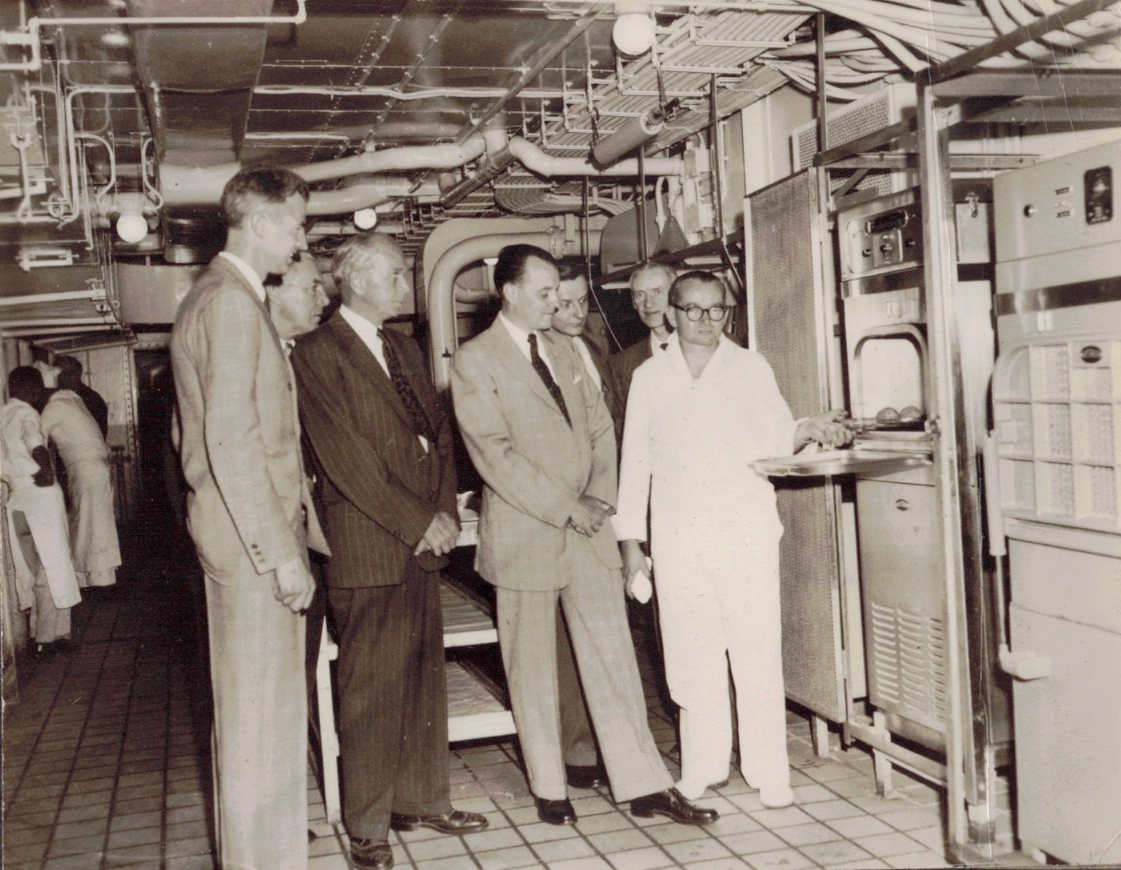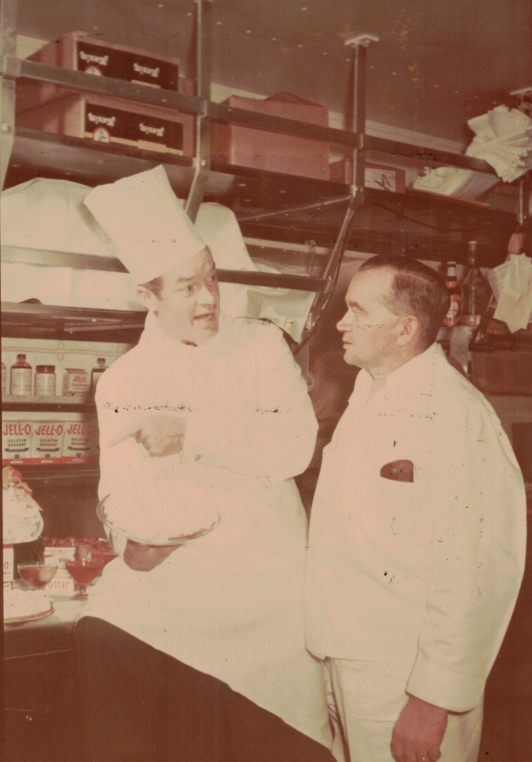FOOD TASTES BETTER AT SEA:
Dining Aboard the SS United States
Take a Seat | Setting the Table | What's on the Menu?
Innovation and Tech | Back of House | An Enduring Legacy
Guest Book | Shop
PREVIOUS: What's on the Menu? | NEXT: Back of House
INNOVATION AND TECHNOLOGY
Dining aboard the SS United States felt like something out of a science fiction novel. Not only was the food delicious, it was prepared using the "most modern cooking facilities," new technologies most Americans had never used or experienced.
Head Chef Otto Bismarck demonstrates the Radarange on the
SS America, photo featured in the New York Times.
SS United States Conservancy Collection. Courtesy of Otto’s son, Fred Bismarck.
"This has revolutionized cooking.
You just electrocute the food.
How does it work? I don't know.
I think it has got something to do with radar."
Otto Bismarck
(New York Times, 1957)
“Bismarck described the Radarange as ‘revolutionary’ and with unlimited possibilities.”
(New York Times, 1949)
"All the hot food was prepared in "Radar Ranges," probably the first large use of what we call microwaves today.
I sent my steak back to the kitchen several times before I learned that
it didn't turn brown in the radar range.
But boy, it was delicious!"Marion Jones
former crew member
RADARANGE
Before the "microwave" was the Radarange. The development of radar technologies during World War II led to the creation of the Radarange, released in 1947. A standard machine was over five feet tall, wide and heavy. It was too expensive and large for home use, but it flourished in the food industry. Restaurants and hotels across the U.S began to experiment with Radarange cooking.
It was long believed that the SS United States was the first ocean liner to feature the groundbreaking machine. But it was in fact the SS America which earned that distinction, another ship designed by William F. Gibbs in the United States Lines fleet. In 1949, the Radarange was introduced on the SS America, overseen by Head Chef Otto Bismarck. Only a few years later, the Radarange became an important part of the SS United States kitchen, and Head Chef Bismarck joined the SS United States crew.
While the Radarange made food quickly and easily, the resulting dishes didn't always look as expected - especially the steak. Meat didn't brown in the same way as when cooked on the stovetop. SS United States Head Chef Otto Bismarck ultimately created a special brown sauce to disguise this fact, and no one was the wiser.
Kitchen crew developed a number of special Radarange recipes, delighting passengers with the novel technology. Press outlets reported on the SS United States' use of the Radarange with great interest. The Radarange would not expand into home kitchens until the late 1960s, and was still too expensive for most households to afford until much later.
The Radarange was manufactured by Raytheon, which also provided other important machines aboard the SS United States, like the Mariners Pathfinder Radar, Reflection Plotter, and Submarine Signal Division Fathometers. During the 1952 Sea Trials, Raytheon executives were invited aboard as special guests, including company president Charles F. Adams Jr. and Dr. Edward L. Bowles.
Head Chef Otto Bismarck shows off the Radarange to Raytheon executives. This photo may be on the SS United States or the SS America. SS United States Conservancy Collection. Courtesy of Otto’s son, Fred Bismarck.
Here, Head Chef Otto Bismarck and world-famous comedian Bob Hope chat in a Galley. Look closely behind Bob Hope to see a wall full of Jello, a typical mid-century refrigerated treat.
SS United States Conservancy Collection. Courtesy of Otto’s son, Fred Bismarck.
Huge refrigerated rooms, located on C Deck, were carefully divided by food type and even voyage direction. There were rooms dedicated solely to ice cream, cheese, and eggs; meats were separated by type and direction of the voyage: smoked meat, kosher meat, meat for westbound trips, and meat for eastbound trips. Even cigars and tobacco were kept cool in dedicated storage rooms. Foods were thawed and chilled respectively in the appropriate rooms. When it came time to cook the food, crew members carried the precious cargo via elevator or dumbwaiter to the galleys and pantries on A Deck, two decks above. Smaller refrigerated rooms were located on A Deck, complimenting the cooking spaces. HVAC manuals for the ship explain how refrigerated spaces were controlled with tempered air systems and two-speed fans.
The vast refrigerators onboard allowed the kitchens to prepare delicacies like Jello and frozen ice cream cakes. These foods, now taken for granted in the 21st century, were prized at the time not especially for their taste, but because they represented access to refrigeration. Every plate of perfectly chilled Jello delivered to an eager passenger was a testament to the complex technology and efficiency aboard the SS United States.
“Aboard the United States the most modern cooking facilities are much in evidence. Here a battery of amazing radar-cooking ranges can make a steak sizzle in a matter of seconds... huge refrigeration units keep your food always fresh.””
This HVAC Manual details the thorough processes necessary to operate the heating, cooling, refrigeration, and fire safety onboard.
SS United States Conservancy Collection. Donated in memory of Thomas A. "Tom" Gilbertson, P.E., an HVAC technician who worked with previous owner of the SS United States, Robert Hadley, to redevelop the ship.
REFRIGERATION
When refrigerators were first introduced into homes in the 1930s, many Americans were wary. For centuries, food was simply eaten before it went bad, or preserved by pickling or salting. Refrigerated food was seen as untrustworthy, unhealthy, and unnatural. Thanks to persistent advertising, and the technological revolutions of World War II, Americans started to trust the refrigerator. By the end of the war, households were clamoring for new appliances. As the United States emerged as a global power, these new technologies represented American culture as a whole - new, shiny, and powerful. In 1959, then-vice president Richard Nixon touted American kitchen innovations in a series of public debates with Soviet premier Nikita Khrushchev, henceforth known as the Kitchen Debate. In the Cold War, the fridge was an all-American, capitalist symbol.
Much like the fridge, the SS United States was a cultural symbol and tool in the Cold War. The ship represented post-war prosperity, technology, and dominion over the seas. Unlike the fridge, the SS United States was a secret military weapon to be deployed if the Cold War got hot. The ship was capable of feeding 3,000 passengers and crew, and if needed, 14,000 military personnel as a high-speed troop transport in war.
Blueprints of C Deck reveal the complex labyrinth of refrigerated rooms.
SS United States Conservancy Collection.
FIRE SAFETY
Chief designer of the SS United States William F. Gibbs was obsessed with fire safety. Horrified by maritime fire disasters of the SS Morro Castle and SS Normandie, he insisted the SS United States be fully fireproof. He allowed absolutely no flammable or wooden items on board. The only permitted wooden objects were a butcher's block and custom Steinway piano.
In the unfortunate case of fire, there were complex and detailed processes in place. Each part of the ship was organized by "fire zones", the galleys and pantries being in Fire Zones 4, 5, and 6. In the event of fire, ventilation fans in these zones automatically shut down, thanks to CO2 pressure operated electric interlock switches. Without any air flow or oxygen, the fire would be isolated and unable to spread. Fire dampers above every range and griddle would also immediately detect changes in temperature and CO2, and shut down ventilation. These protections exceeded all legal requirements and were singularly thorough compared to every other passenger vessel. Thankfully, the threat of fire never came to pass on the SS United States, and Gibbs' obsessive attention to detail kept passengers and crew safe.
“Below decks, in the engineering room, behind the scenes, these are the hidden treasures of this ship. The speed records, the hull design, the graceful symmetry, the reflection of state of the art 1952 technology are captured in this ship...”
Bert Armington
(1961 Tourist Class passenger)





